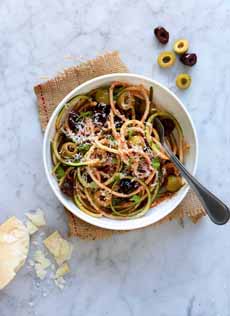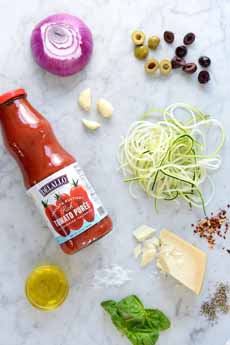RECIPE: Zoodles (Zucchini Noodles) & Olives
|
Zucchini is at its lowest price of the year: time to get out your spiralizer and make zoodles (zucchini noodles, a.k.a. zucchini spaghetti). If you don’t have a spiralizer and don’t want to buy one, you can find ready-to-cook zoodles in most supermarkets. DeLallo created this zoodles recipe using their passata rustica tomato puree, briny olives, and lots of fresh basil and parmesan (photo #2). Try this lighter take on spaghetti and tomato sauce for your next pasta night! Ingredients For 4 Servings 1. HEAT 1 tablespoon of olive oil in a high-rimmed skillet over medium heat. Add the entire onion half and sauté on one side for 2 minutes. Flip and sauté on other side for 2 more minutes. 2. ADD the garlic and sauté until fragrant, about 1 minute. Add the tomato purée and basil leaves, then cover and simmer on low heat for 30 minutes, stirring about every 5 minutes. Meanwhile… 3. TRIM the zucchini ends and use a spiralizer to create noodles. If you don’t have a spiralizer, use a vegetable peeler to create long ribbons. Place noodles in a bowl and cover with cold water until ready to cook. When you’re ready to cook… 4. DRAIN the noodles and pat them dry. Heat 1 tablespoon of olive oil in a skillet over medium heat. Add the zucchini and sauté while stirring for 2-3 minutes. |
|
|
|
5. REMOVE the onion, garlic and basil leaves from the sauce. Add the cooked zoodles and olives, and stir to coat. Place the zoodle mixture on plates, sprinkle with cheese and chopped basil, and serve. WHAT IS TOMATO PASSATA? How does passata differ from tomato paste and tomato sauce? Passata is the Italian term for an uncooked tomato purée that has been strained to remove seeds and skins. It is also spelled passato and referred to by its full name, passata di pomodoro, and it can also be labeled “strained tomatoes.” It has a thicker consistency and a deeper flavor than tomato sauce. If you need passata for a recipe but can’t find it, buy plain canned tomatoes and process them through a food mill or food processor. In the U.S. and elsewhere, tomato purée is usually cooked briefly to soften the tomatoes before processing (puréeing) them. Because it is minimally cooked, tomato purée has a mild, fresh tomato taste and a thinner consistency. Tomato paste is the thickest and most concentrated of the three. It is made by simmering tomatoes for several hours, cooking them down to a thick, rich paste that has a sweet, intense tomato flavor (some find it similar to sundried tomatoes). Tomato sauce is made with tomato paste, tomato purée, or both (it can also be made from scratch with fresh tomatoes). It often has other ingredients such as carrots, garlic, herbs and onions. You would not want to substitute either product if passata is called for in your recipe.
|
||




